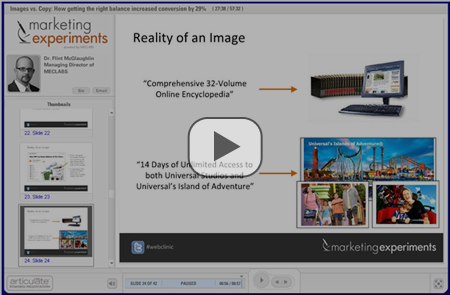Recently, I had the pleasure of watching an hour long webinar on images and copy on a webpage. The presentation was by our friends at Marketing Experiments.
And while this webinar is a little old now (originally airing in November), it contains some great commentary on how web marketers can approach and find the right balance between images and copy on their webpages.
Perhaps the biggest take-away I got from the webinar was this – “People don’t buy from websites, they buy from people”
This is perhaps one of the most insightful comments on web marketing I’ve ever heard and will do my best to remember it going forward. But for now, let me give you a quick review of the presentation and invite you to take an hour to watch it yourself – you certainly won’t come away disappointed.
Starting out, Marketing Experiments director Dr. Flint McGlaughlin explained how a lot of things common to websites pose impediments to conversions. Perhaps you know what he’s talking about here – many websites contain or don’t contain elements that prevent you from getting the maximum amount of conversions.
That’s where the Principle of Congruence comes in, which requires every element of a page state or support your page’s value proposition.
Say your value proposition is custom-made products shipped fast – do all of the elements of your page work to support this value proposition?
Images or Copy – Which do I focus on more?
When approaching this question, you need to ask yourself what communicates value more effectively – images or copy – according to Flint and the researchers at MECLABS.
The effectiveness of any webpage element to communicate the value proposition can be measured by the following two capabilities:
1. Ability to communicate value with force
2. Ability to communicate value with precision
When considering images and copy, keep in mind that images have a greater potential to communicate value with force and copy has greater potential to communicate value with precision.
Images
The force of an image is directly related to three things:
1. Relevance – an image’s force increases as the connection between the image and perceived value becomes clearer. Images are great for communicating brand.
2. Reality – an image’s force increases with its authenticity. Images can reduce the distance between the actual value and the reader’s perception of that value (see example in slide #23).
3. Relative Weight – an image’s force increases as its relative graphical proportion increases…or in layman’s terms, images that look different than other elements on a page get your attention. This naturally draws the reader’s eye-path. Therefore, if the image provides proper relevance and reality, it will bring more force to bear on the inherit value.
Copy
In short, copy has two distinct advantages over images.
First of all, copy has the ability to include specific, quantifiable detail to your webpage. Secondly, copy gives your site personality and has the ability to include a tone that matches your visitors’ motivations.
Of course, there’s a right way and wrong way to use copy. You don’t want to use phrases that make you seem arrogant – examples include “Your Hunt is Over” and so on.
Also, be careful about your call-to-action copy. In their example (slide #30), a form has an intimidating tone that seems to imply that you will receive incessant phone calls from sales people once you complete it.
What about SEO?
Last but not least, Dr. Flint and the team at MECLABS explored the impacts all of this has on search engine optimization. How do you balance landing page optimization (LPO) with SEO?
In a sense, SEO is a secondary concern. You first need to work on maximizing conversions and then worry about boosting search rankings afterwards. There are many examples of high-ranking pages that fail to convert because the site owner focused solely on SEO, which according to Dr. Flint is just a channel to get people to your page. In other words, it’s a means to an end, not the end itself.
They outlined some questions to consider when identifying the proper balance between SEO and LPO:
1. Where does your traffic come from? If it’s organic, how well does it convert visitors into customers?
2. What are your needs in terms of LPO and what’s its potential impact? Are the needs radical or minor? How much will these changes affect your bottom line?
3. What contributes the most to your SEO ranking – content or authority?
4. Can you measure the impact of page changes?
After discussing some ways to identify the proper SEO/LPO balance, Dr. Flint and the team evaluated a couple of sites given to them by one of the webinar’s original participants and offered tips on how to strike the right balance between images and copy to maximize conversions.
In the end, the webinar is well worth the one-hour it takes to watch it and take some notes. I’m sure I’m leaving something out since it was so extensive and informative. Watch the video or tell us about your experiences in using images and copy and how well your balance worked to increase conversions.

Or listen to an audio version here.
Until next time…
